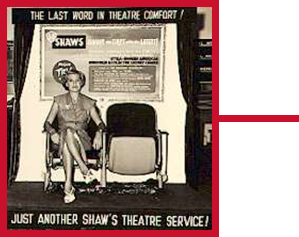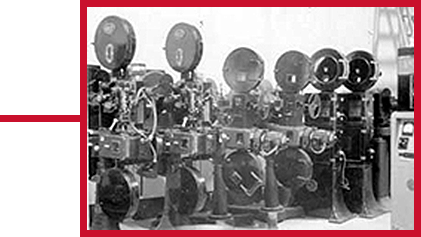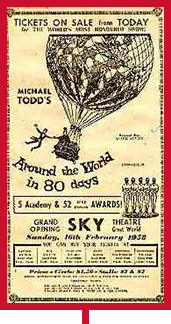HOME / ABOUT SHAW / Singapore, Post War
Singapore, Post War
Shaw Cinemas, Post War, Singapore (1945-1970)
With increasing competition from other post war exhibitors and forms of mass entertainment, Shaw cinemas aimed to offer the best movie experience possible. In order to keep abreast with world exhibition standards, the Equipment and Engineering Department had to import the latest in cinematograph equipment, sound systems, theatre equipment, furnishings, air-conditioning and chairs. Then and now, patrons who visit Shaw cinemas are assured the latest in cinema comfort and technology.
Until the end of the war, Shaw cinemas employed projection via Simplex projectors. Mono sound was the norm and were delivered via speakers with brands like 'Jensen'. Some of the better cinemas were installed with the then highly touted Westrex Masters sound system. Screens were made of Normal cloth averaging 18' by 16' and seats were constructed of plywood or rattan.
Most theatres had a stand by motor generator because public power was not reliable.
Most theatres had a stand by motor generator because public power was not reliable.
From the mid-1950s, new Simplex XL projectors replaced old models, stereo replaced mono and to eliminate reverberence, acoustic fiberglass paneling made of glass wool made their way into cinema walls and ceiling. For comfort, American Bodiform upholstery chairs replaced plywood seats. In front of the halls, perforated plastic replaced cloth screens. In a few major cinemas, even CinemaScope screens were being installed.

Shaw theatre seat display, 1950s
By 1960, the better cinemas had been fitted with Frick air-conditioners, four/six channel magnetic stereo surround sound systems and convertible 35mm/70mm water-cooled Simplex projectors. To complete the experience, all purpose high-gain screens for CinemaScope, SuperScope, VistaVision and wide-screen projection were
installed. These screens measured up to a whopping 60' by 30'.
Although such equipment skyrocketed costs (By 1959, the Lido Theatre in Singapore were the most expensive to outfit at $2.4 mil), they made it possible to screen any type of films developed by Hollywood.
Although such equipment skyrocketed costs (By 1959, the Lido Theatre in Singapore were the most expensive to outfit at $2.4 mil), they made it possible to screen any type of films developed by Hollywood.
Over the years, besides improvements in the quality of colour and sound, other innovative methods for enhancing the cinema experience were constantly being launched from Hollywood. Many of these special format films were shortlived, but they renewed excitement in cinema during the various periods they were launched.
Simplex Projectors


The Grand Opening Premiere of Sky,
Around The World in 80 Days, 1958
Around The World in 80 Days, 1958
In 1953, a spate of 3-D films were launched to much fanfare at the Capitol with United Artist's 'Bwana Devil' starring Barbara Britton, Shirley Tegge and Robert Stack leading the pack. It was followed by Warner's 'House of Wax' (1953) starring Vincent Price. That same year saw the first 3-D film in technicolor, 'Fort Ti', starring George Montgomery. Although the 3-D films were applauded by most, there were numerous complaints that the imported polaroid glasses were not particularly comfortable nor secure.
In 1959, the Sky cinema was fitted with Cinerama was an entirely new movie experience where three projectors would project a third of a film each on a semi-circular screen. The first film screened in this format was "This Is
In 1959, the Sky cinema was fitted with Cinerama was an entirely new movie experience where three projectors would project a third of a film each on a semi-circular screen. The first film screened in this format was "This Is
Cinerama". In the film, the three synchronized projectors surrounded audiences with a roller coaster ride and 'Niagera Falls' in stereophonic sound. The semi-circular screen provided a wide angle-panorama of 120 degrees. This is approximately the vision range of the human eye.
Eager to experience the new sensation, patrons travelled from as far as Borneo to Singapore. The Sky had only 2 shows for the concept film - a 6.15 pm and a 9.15 pm show. Tickets were priced at $4, $2.50 and $1. Even foreign dignataries like Tenku Abdul Rahman Putra, former Prime Minister of Malaysia and Rani Subama Shamsher Jung Bhadur Rana, former deputy Prime Minister of Nepal visited the Sky to see Cinerama.
Eager to experience the new sensation, patrons travelled from as far as Borneo to Singapore. The Sky had only 2 shows for the concept film - a 6.15 pm and a 9.15 pm show. Tickets were priced at $4, $2.50 and $1. Even foreign dignataries like Tenku Abdul Rahman Putra, former Prime Minister of Malaysia and Rani Subama Shamsher Jung Bhadur Rana, former deputy Prime Minister of Nepal visited the Sky to see Cinerama.

In the 1970s, Cinerama used a single lens system which eliminated the distinctly vertical lines which cut the screen into three sectors. Other Cinerama films shown were Krakatoa East of Java and Stanley Kubricks 2001, A Space Odyssey. Although the popular use of large formats such as Cinerama eventually went out of style, the goal of giving cinema audiences a total 'immersive' theatrical experience continued.
In 1974, Universal's 'Earthquake' launched Sensurround, a sound system which created sub-sonic, low-frequency vibrations to simulate the sensation of small tremors in the theater. Shaw cinemas had to be retrofitted with the system so that they could physically vibrate during quake sequences. A warning for the faint-hearted flashed on the screen before the film began. Other Sensurround films followed, including CIC's 'The Battle of Midway' and
'Rollercoaster', but this form of sound effects engineering to boost audience participation proved shortlived. From the 1980s, with the proliferation of cineplexes and smaller screens, sound increasingly became the preferred way to achieve that goal. With the widespread adoption of digital surround sound, audiences could now benefit from a 'spacial' experience within a smaller confine.
Next Story